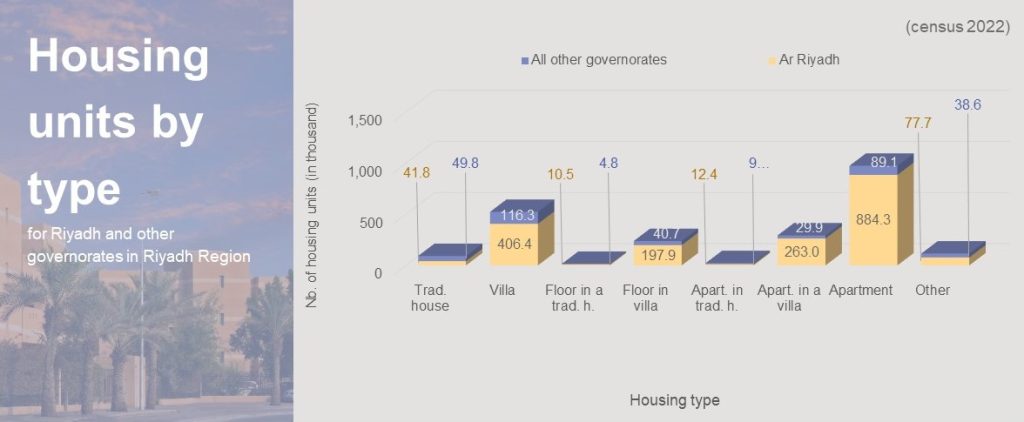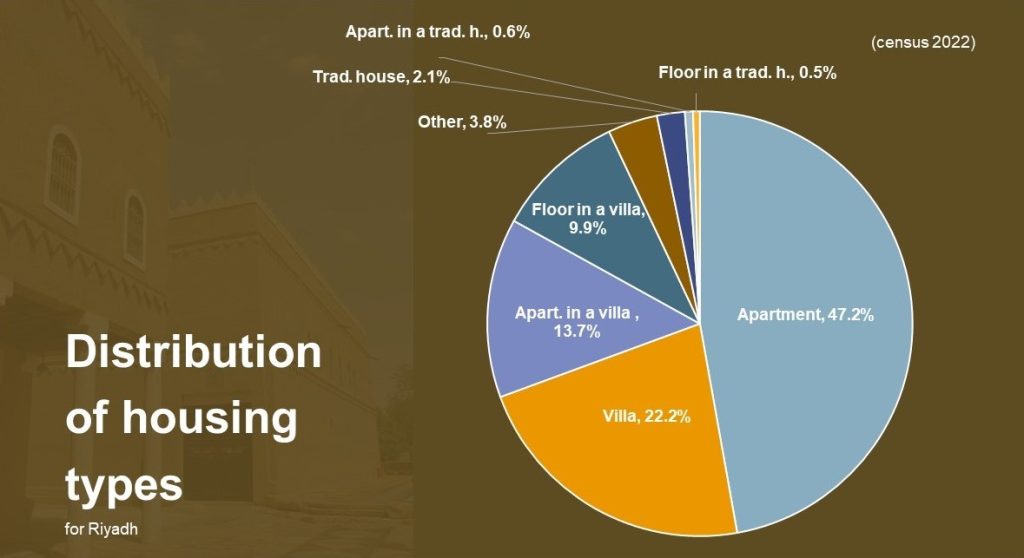As a key indicator of the quality of life of its citizens, the Riyadh Open Data Portal provides datasets on housing conditions throughout the territory. They can be located under the ‘Environment / Energy / Housing’ tab out of the nine themes of the portal.
The Strategy of the Riyadh Open Data Portal is driven by master goals or Macro. Goals (MG) for the city. Housing is included in 2 out of the 4 MGs:
- With a target to reach 10 million people (MG#2) through the development of talents in a booming economic environment, a long-term policy for housing has to be implemented immediately to prepare infrastructures and related organizations;
- “Housing” is a crucial pillar for preserving people’s quality of life (MG#3). The RCRC is developing policies that focus on the provision of decent housing solutions for everybody.

Each Macro. Goals is further divided into key objectives. MG#2, for instance, involves a key objective titled “Sustainable & affordable residential places”, which comprises datasets that can enable researchers, students, professionals of the field, or any citizen to contribute to making housing solutions better throughout the city. In a non-exhaustive way, typical relevant datasets include:
- Population by age, by sex, by family structure and by migration characteristics, and to a wider extent, by families and households;
- Dwellings and housing arrangements;
- Housing conditions: overcrowding rate, housing costs.
How does it apply to urban analysis?
Housing is at the heart of the city’s growth and development policies. Urban plans are defined according to identified long-term growth sectors. They enable the deployment of appropriate infrastructures: roads, water sanitation facilities, electricity, and telecommunications. Then, private and public stakeholders from the land and real estate sectors bring to the table their investment capabilities and ideas to develop value-added projects for households and new businesses.
When looking for new projects, investors need to get the answer to a number of questions that help them assess potential challenges:
- What type of building will be constructed?
- What clients will be targeted?
- What population is to be attracted?
- What public and private facilities will be made available, particularly regarding education, training, health, and transportation?
- What commercial services will fulfill the residents’ needs?
- What equipment and maintenance service will be put in place for a given specific housing and building project?
- How will the transportation offer of Riyadh City support this development?
- How will leisure and sports infrastructures ensure a good quality of life for families?
What data do we offer?
Our growing Catalog of datasets is there to fulfill the needs of both businesses and individuals:
- Data on the typology of houses, tenure status, and building usage.
- Data on population, age, sex and citizenship distribution, households’ size, and marital status.
Once the platform becomes more mature, further datasets are planned:
- Subdivision, construction, demolition permits, changes of purpose (residential, offices, businesses, equipment);
- Data on networks such as water, electricity, household waste, sanitation, transportation, telephone, Internet, etc.
- Data on real estate and construction, markets, property value, neighborhood attractiveness, occupancy turnover, etc.
- Geospatial data from the land use department at RCRC will display data on maps for a more attractive visualization, along with approved real estate operations.
Some data have already been made available at the level of the “Hay” (neighborhoods). This is in line with one of the targets of the Riyadh Open Data Strategy, which is to give citizens access to detailed information that can be of use at a smaller scale.
The Riyadh Open Data Strategy also takes into consideration the position of Riyadh within the Riyadh Region and the Kingdom. National data are often republished on this platform for this purpose. Those datasets are of great help for comparing cities, understanding the dimensioning of urban distribution networks, choosing priorities within strategic frameworks of the city, generating ideas for personal or professional development, or as part of the search for public/private partnerships.
Figure 1:

As of today, the Riyadh city offers around 406,400 villas, 198,000 floors in traditional houses, and 263,000 in-house apartments in villas.
Riyadh counts 52,000 traditional houses, about 10 times fewer than villas. Buildings allocated to housing make for around 884,000 apartments (see Figure 1).
Riyadh is a modern and relatively dense city where the residence of choice of its inhabitants continues to be individual housing.
Many other insights are accessible from the detailed datasets.
Uses for governance purposes
Our datasets could help any dignitary and decision-making representative monitor regularly the city development district by district. They enable to identify points of interest and shortcomings, follow-up on corrective measures applied to government programs, and adjust development strategies according to priority objectives.
The Riyadh Open Data Portal aims to bring quantitative and qualitative elements to different services, using town planning and city management information: they enable to prepare better reports and to issue recommendations for decision-making and strategy definition.
Estimating the equipment needed for a given project by anticipating needs in the most sustainable way, is a difficult task. Even more so whilst reinforcing the potential attractiveness of neighborhoods and considering all needs and constraints. The Riyadh Open Data is a powerful tool to reach those goals.
Figure 2:

The number of housing units by type and density are the most frequently used data to frame decisions and needs. They are also reliable since they are monitored from different angles, from design to marketing and population settlements. Combined to management data, they become very powerful datasets. Today, 47% of housing units in Riyadh City are apartments located in buildings (see Figure 2). How will this proportion evolve with time? This should be considered by the services sectors responsible for infrastructures in order to calibrate water supply, electricity, telephone networks and, of course, road and transport services. Town planners also need to keep track on the development plan of houses, public spaces, green spaces, and the capacity to accommodate businesses and services. The programming of school facilities is first based on housing data, to which household composition data from censuses or specific surveys are attached.
This list of examples is not exhaustive.
Uses for urban and housing solutions developers, and institutions managing infrastructures
The housing sub-theme of the Riyadh Open Data Portal offers quantitative and qualitative elements that enable to assess the advantages of investing in a project, to organize a business plan, to prepare a firm’s operating model and to determine their needs in terms of equipment and staff.
It is a powerful tool to evaluate the potential and feasibility of projects, ideas and more: certain sectors can lose their attractiveness due to nuisances or changes in populations. On the contrary, others can be boosted by the installation of new equipment or a new metro line, or even by the arrival of a new company in the area.
The housing datasets improve profitability by diversifying risks, and by focusing on certain neighborhoods, customer segments, and types of housing or premises.
Figure 3:

The housing datasets improve profitability by diversifying risks, and by focusing on certain neighborhoods, customer segments, and types of housing or premises.
State services reserve some 34,000 houses for their civil servants whilst the private sector offers 161,000 housing units to their employees. Some 1,182,000 households are renting (see Figure 3), with 25% of them being Saudis [1]. This means that ¾ of rentals are subjected to the renewal of employment contracts and immigration policies, both linked to labor needs and the penetration of young people into the labor market.
Uses for owners and tenants
Owners and tenants can use the data from the Portal to best choose their location of residence, based on the city’s existing or future housing offer. Thanks to those data, they can make choices depending on the composition of their household, their professional activity, their commuting needs between home and work, available means of transport, and their budget for investment or rent.
A significant part of the data is based on quantity, housing supply, location of construction programs, investment costs and capacity to finance it, rental costs and budget share. Certain indicators are already on the Open Data Platform, such as housing typology. Other datasets will be uploaded when available, in particular those relating to housing density, real estate price evolution, and the construction and development of new neighborhoods.
Other data are more qualitative, such as the proximity of facilities, in particular regarding children’s schools, green spaces, services and commercial activities, accessibility by transportation means other than private cars, etc.
Uses for citizens
Citizens can get a lot of information from the Riyadh Open Data Platform such as a synthetic and increasingly detailed view of how the city operates its services and “what is available where?
It is also an instrument of dialogue to question public authorities on its policies and to alert them to possible dysfunctions. The Platform will enable citizens to express their needs regarding:
New housing solutions;
Renovation of existing houses;
Network problems (Internet, telephone);
Assistance in case of unforeseen events such as floodings or sandstorms;
Regulation of water supplies, sanitation, and electricity.
Uses for corporate organizations and investors
Aside from construction and real estate considerations, any corporate organization or investor with a development plan in mind could benefit from using the Riyadh Open Data Platform. These official data enable to assess any need related to housing, be it furniture, home equipment, fabrics and carpets, electronics, telephony, sanitary facilities, cars, etc.
They can help evaluate potential customers for the provision of food, catering, personal services, but also banking, insurance, telephone subscriptions, gyms, health services, etc.
Figure 4:

When available, detailed data at neighborhood level make it possible to specify an optimal location based on housing types and characteristics. This is useful for drawing catchment areas and for profitability simulations, among other investment decision-making. For example, both the Hay of Tuwaiq and An Nadhim are populated by large households of an average of 4.5 people (see Figure 4).
Conclusion
The Riyadh Open Data Portal makes a large number of public, reliable, reusable datasets publicly available. They target the city and its region and enable comparisons at different scales. The juxtaposition of datasets makes it possible to get a precise and objective idea of the components of the city and its neighborhoods, evaluate customer potential, target public and private investments, articulate actions to better serve populations, and optimize budgets. Global data and data by Hay are fully complementary in meeting the needs of numerous studies and developing realistic propositions to achieve the strategic objectives of Riyadh.
Get more on this article
Figure 1: Learn more about housing units by housing type and by governorate in the Kingdom on the Saudi Census 2022 web page.
Figure 2: Learn more about the distribution of housing units by housing type and by hay in Riyadh on the Portal.
Figure 3: Learn more about housing units by tenure status in Riyadh on the Portal.
Figure 4: Learn more about households’ size in Riyadh on the Portal.
[1] Saudi Census 2022.

